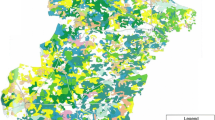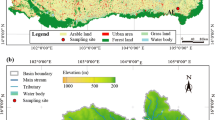Abstract
Monitoring of soil-water physiochemistry (pH, total salt content, ion types, and ion ratios) across the lower Heihe River basin of northwestern China indicated that the distribution of different soil hydrochemical types typically correlated with that of different levels of soil desertification, specifically: 1) lands with the potential for desertification showed a Cl−-SO 2−4 -Na+-Mg2+ soil-water ion complement, 2) those under on-going desertification a SO 2−4 -Cl−-Mg2+-Na+ ion complement, 3) those under severe desertification a HCO −3 -Cl−-Ca2+-Na+ ion complement, and 4) those under very severe desertification a Cl−-SO 2−4 -Mg2+-Na+ ion complement. The total soil N, P, and K, pH and organic matter of desertified lands tend to be relatively spatially concentrated, whereas available N, P and K are scattered. Based on an analysis of the main nutrients, the cumulative percent contribution of total N, total P, organic matter, and available N reached 76.24% of ecosystem needs and basically reflect the level of soil fertility. According to a low-dimensional cluster analysis of principal components and the differentiation and alikeness of integrated nutrient gradients, the soils in the study region were classified into four types, which coincided spatially with the four desertification land types. With a decrease in the quantity of water exiting the upper and middle reaches of the Heihe River basin, the salinity of surface waters and shallow water table depth (WTD) in the lower reaches have significantly increased through evaporation. The changes in the hydrological process have caused an imbalance in water distribution across the basin, and altered the state of oasis-supporting water resources. The deterioration of soil water and expansion of desertification progress from non-salinized soils in the oasis, to soils slightly salinized through periodic salt accumulation, salinized Chao soils, and salinized forest shrub meadow soils along the riverbanks and on lake shores. These can then evolve into moderately to heavily salinized soils and eventually into alkali lands. All together, these degradative processes constitute the complex dynamics of oasis desertification, whereby the natural oases’ surface biotic productivity system is degraded, leading to oasis shrinkage, ecosystem deterioration, and land desertification. Consequently, there is an urgent need to extend the study of soil and surface water chemistry in the region.
Similar content being viewed by others
References
Bao S D (2005). Analysis of Soil Agronomic Chemistry (third edition). Beijing: Chinese Agriculture Press, 495 (in Chinese)
Feng Q, Liu W, Su Y H, Zhang Y W, Si J H (2004). Distribution and evolution of water chemistry in Heihe river basin. Environmental Geology, 45(7): 947–956
He W S (2004). Temporal and spatial variability of soil nutrients in plough layer of farmland soils in Ningxia province. Chinese Journal of Soil Science, 35(6): 170–174 (in Chinese with English Abstract)
Lei Z D, Yang S X, Xie S C (1984). Analysis of diving stable evaporation and experience formula. Journal of Hydraulic Engineering, 60–64
Lei Z D, Yang S X, Xie S C (1988). Dynamics of Soil Water. Beijing: Tsinghua University Press, 141–146 (in Chinese)
Liu W, Wang T, Su Y H, Feng Q (2005). Analysis of the characteristics of soil and groundwater salinity in the lower reaches of Heihe River. Journal of Glaciology and Geocryology, 27(6): 890–899 (in Chinese with English Abstract)
Liu M, Gan Z M (2004). Influence of water resources development on Ejin oasis in Heihe river basin and countermeasures. Journal of Desert Research, 24(2): 162–166 (in Chinese with English Abstract)
Lou F L (1964). The relationship between soil accumulating salt and groundwater. Journal of Hydraulic Engineering, (3): 1–11
Mao X M, Li M, Shen Y L (1998). Analysis of the phreatic evaporation in yarkant river basin, Xingjian. Arid Land Geography, 21(3): 44–50 (in Chinese with English Abstract)
Smart P, Tovery K (1981). Electron Microscopy of Soils and Sediments. New York: Oxford University Press
Su Y H, Feng Q, Liu W, Shi J H (2004). The degradation of ecological environment in Ejin and its cause analysis. Plateau Meteorology, 23(2): 264–270 (in Chinese with English Abstract)
Team of soil system classification Institute of Soil Nanjing, CAS (1991). Item of soil laboratory analysis and methods codes (soil system classification in china), 68–71 (in Chinese)
TPS Pty Ltd., Australia (2001). TPS Australia-Quality hand-made instruments. http://www.tps.com.au/
Yan L, Hu Y C, Dong Z (2000). Primary study of soil salinity character in Ejin oasis. Journal of Arid Land Resources and Environment, 14(Suppl): 25–30
Zhang X Y, Gong J D, Zhou MX (2004). Analysis on Characters of Soil Salinity in Ejin Delta. Journal of Desert Research, 24(4): 442–447 (in Chinese with English Abstract)
Zhang Z X (2002). Matlab Procedure Design and Application. Beijing: Tsinghua University Press, 11 (in Chinese)
Zhou L (1988). Research on growth of Eremophila alpestris nestling II-main principle analysis of measuring indices of Eremophila alpestris nestling growing. Colloquium of International Learning Conference About High Altitude and Cold Meadow Ecological System (C), 10
Author information
Authors and Affiliations
Corresponding author
Rights and permissions
About this article
Cite this article
Feng, Q., Liu, W. & Xi, H. Relationship between soil physiochemistry and land degradation in the lower Heihe River basin of northwestern China. Front. Earth Sci. China 3, 490–499 (2009). https://doi.org/10.1007/s11707-009-0061-1
Received:
Accepted:
Published:
Issue Date:
DOI: https://doi.org/10.1007/s11707-009-0061-1




